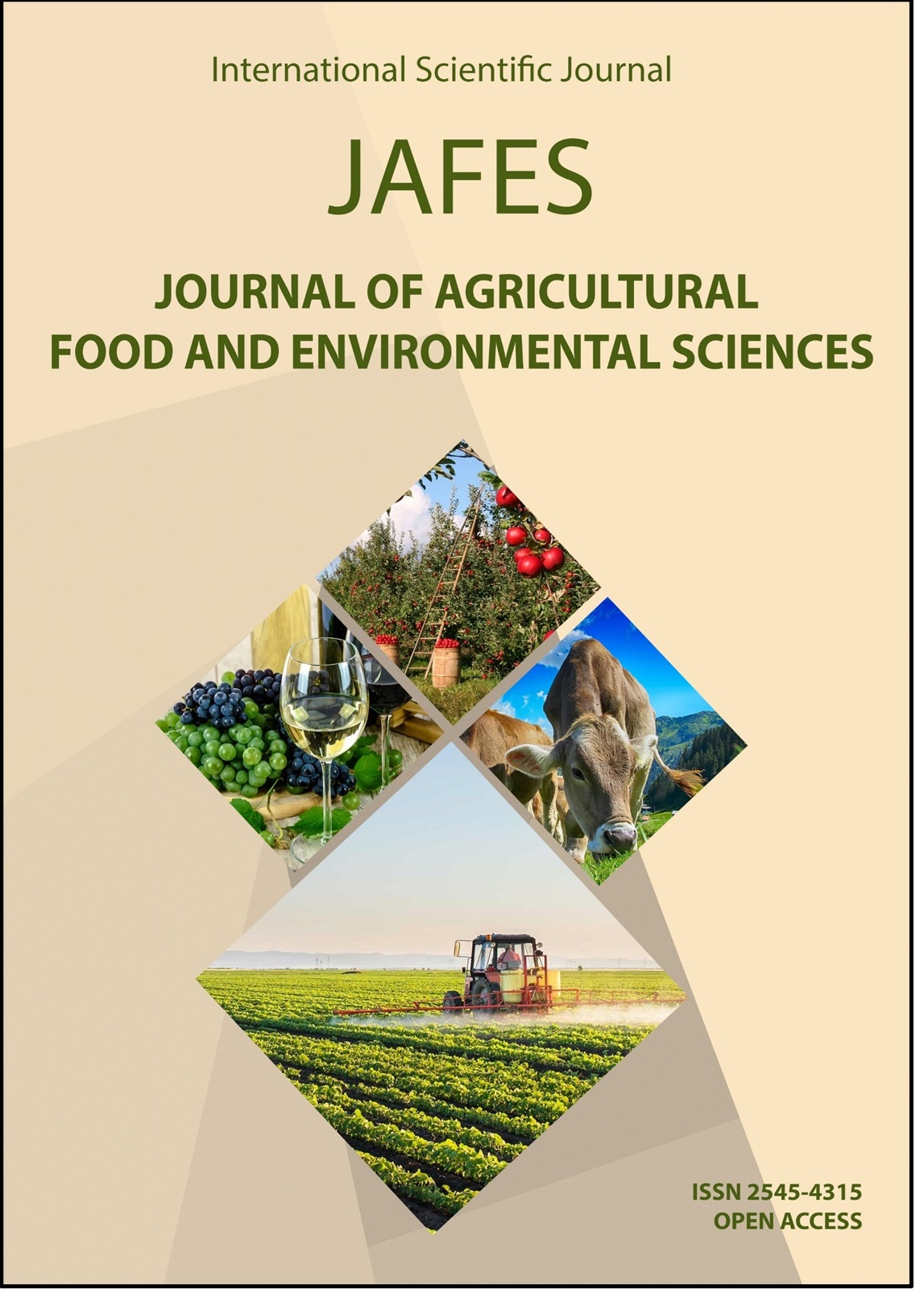COMPARATIVE STUDY OF SHEEP MILK, WHEY AND TRADITIONAL KASHKAVAL FROM GALICHNIK AND LAZAROPOLE
Клучни зборови:
quality of milk, physico-chemical composition, traditional cheeseАпстракт
Traditional cheeses are a reflection of the local rural environment, culture and nature expressed by experience of masters through many decades. In recent years, it is noticed increased consumption of traditional sheep dairy products, especially cheese produced by traditional technology. The purpose of this study was to examine the quality of raw sheep's milk and whey during the production of traditional sheep cheese from two locations, Galichnik and Lazaropole. Samples were taken in four iterations. The physico-chemical composition on the 100th day of ripening of cheese is presented also. The mean fat content was 8.45± 1.157% in milk from Galichnik and 8.69±0.846% in milk from Lazaropole, while the protein was 6.34±0.837% and 6.15±0.242% respectively. Titratable acidity in Galichnik milk was 10.33°SH and the milk from Lazaropole has 10.50°SH. The Total bacteria count (TBC) and the Somatic cell count (SCC) in both locations showed wide range due to nonstandard sanitary procedures applied in primary production. The results of the chemical composition of whey showed that it has a variable composition, particular in the content of fat (Cv= 9.02% Galichnik and 21.98% Lazaropole) due to the traditional procedure for making cheese. The moisture content of the cheese on 100th day of ripening was 36.64% in cheese from Galichnik and 32.63% in Lazaropole cheese. The mean value for fat content was 27.88% and 30.00% for cheese from Galichnik and Lazaropole respectively. According to the classification of cheese in terms of moisture content on a fat-free basis, after 100 days of ripening, the kashkaval cheese from Galichnik had fallen in the group of hard cheeses, while the kashkaval cheese from Lazaropole belong to the group of extra-hard cheeses. Regarding the fat in dry matter, both cheese variants were on the border between medium fat and full fat cheeses.
Референци
Abou-Donia, S. A. (2004). Developments in Еgyptian kashkaval cheese: an overview article. Alex.J. Fd. Sci. & Technol. Vol. 1 (1): 69-73.
Antunac, N., Hudik, S., Mikulec, N., Maletid, M., Horvat, I., Radeljevid, B., Havranek, J. (2011). Proizvodnja i kemijski sastav Istarske i Paške skute Mljekarstvo 61 (4): 326-335.
Antunac, N., Havranek, J.H. (1999). Proizvodnja, sastav i osobine ovčjeg mlijeka, Mljekarstvo 49 (4): 241-254.
Baltadjieva, M. (1993). Tehnologija na mlecnite produkti. Sofija.
Caric, M., Milanovic, S., Vucelja D. (2000). Standardne metode analize mleka i melcnih proizvoda, Prometej. Novi Sad, 135-138.
Cizbanovski, T. (1981). Sporedni proizvodi vo mlekarskata tehnologija, nivniot hemiski sostav i znacenje. Magisterski trud. Univerzitet Sv. Kiril i Metodij vo Skopje.
De. Roest K. (2000). The production of Parmigiano- Reggiano Cheese. Doctoral thesis Wageningen University.
Dozet, N., Adžic,́ N., Stanišic,́ M., Živic,́ N. 1996. Autohtoni mlječni proizvodi, Poljoprivredni institut - Podgorica, Silmir-Beograd, Beograd, 89-92.
Dozet N., Madej O., Jovanovid S. (2006). Autochthonous milk products basis for specific, original milk products development in modern conditions, Biotechnology in Animal Husbandry, 20,(3-4): 31.
EN ISO (2004): ISO 5534:2004 (IDF 4:2004) Cheese and processed cheese – Determination of the total solids content (Reference method) Geneva: Switzerland: International Organization for Standardization.
FIL-IDF (1993): IDF 20B: 1993 Milk: Determination of nitrogen content Part 1 Kjeldahl Method. Brussels, Belgium International Dairy Federation.
Fox P.F. (2000). Fundamentals of cheese science, Aspen Publishers, 345.
Garde, S., Tomillo, J., Gaya, P., Medina, M., Nunez, M. (2002). Proteolysis in Hispanico cheese manufactured using a mesophilic starter, a thermophilic starter and bateriocin-producing Lactobacillus lac- tis subsp. lactis INIA 415 adjunct culture. J Agric. Food Chem., 50, 3479–85.
ISO (2008): ISO 3433:2008 (IDF 222:2008) Cheese - Determination of fat content- Van Gulik method. Geneva, Switzerland: International Organization for Standardization.
Jeličid, I., Božanic,́ R., Tratnik, Lj. (2008). Whey-based beverages- a new generation of diary products Mljekarstvo 58 (3): 257-274.
Lawrencе, R.C., Gilles, J., Creamer, L.K. (1993). Cheddar cheese and related dry-salted cheese varieties in Cheese: chemistry, physics and microbiology. Volume 1, Chapter 1, 1-38. Second edition. Ed. by Fox, P.F., Chapman & Hall, London.
Mijačevid, Z., Petrovid, M.P., Bulajid, S. (2005). The specific characteristic of Pirot kachkaval. Biotechnology in Animal Husbandry, 21(5-6): 376-378.
Pavid V., Antunac N., Mioč B., Ivankovid A., Havranek J.L. (2002). Influence of stage of lactation on the chemical composition and physical properties of sheep milk. Czech J. Anim. Sci., 47, 2002 (2): 80–84.
Pejid. O., Đorđevid, J. 1963. Mlekarski praktikum. Drugo, izmenjeno izdanje. Naučna knjiga, Beograd, 123-124.
Prpid, Z., Kalit, S., Havranek, J.L., Štimac, M., Jerkovid, S. (2003). Krčki sir. Mljekarstvo 53 (3), 175-194.
Rulebook on special conditions on safety, hygiene and official control of milk and dairy products, Official Gazzette of RM, 26/2012
Santa, D. and Srbinovska, S. (2014). Traditional production and main characteristics of Galichki kashkaval. Mljekarstvo. 64: 119-126.
Talevski, G., Čobanova-Vasilevska, R., Srbinovska, S., Sireta, Z. (2009). Quality of the sheep milk as a raw material in dairy industry of Macedonia. Biotechnology in Animal Husbandry, 25 (5-6): 971-977.
Tarakci, Z., Kucukoner, E. (2006). Changes on physicochemical, lipolysis and proteolysis of vacuum- packed turkish kashar cheese during ripening, Journal of Central European Agriculture. Volume 7 (3): 459-464.



